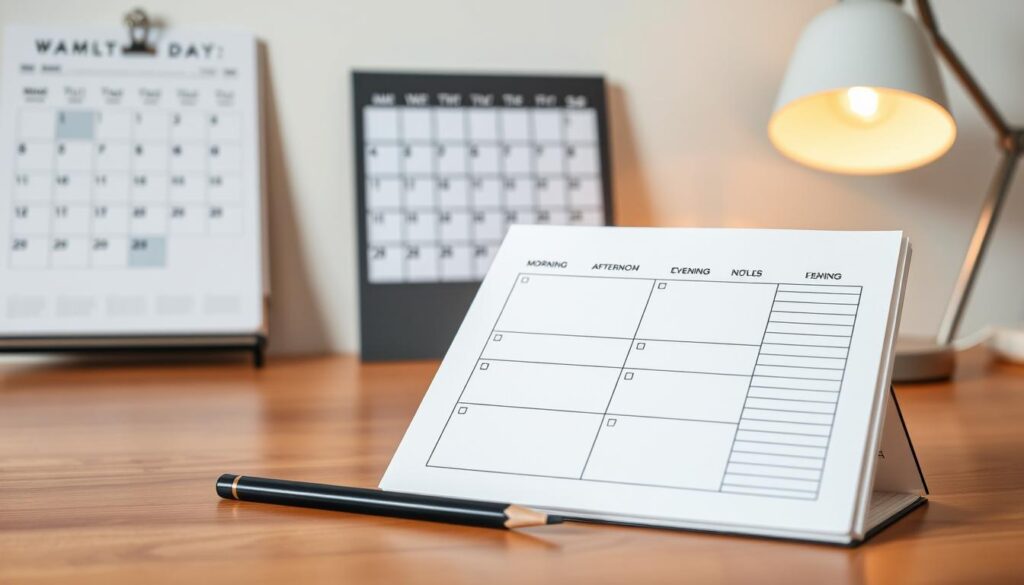Boost your productivity and balance work and life better with a time-blocking daily planner. This tool helps you focus by scheduling tasks into fixed time slots. It’s great for managing your time well.
A time-blocking daily planner is key to being more productive. It lets you control your time and reach your goals. It’s a must-have for anyone looking to manage their time better.

Using a time-blocking daily planner can make you more productive and manage your time better. It keeps you focused, away from distractions, and makes your day more successful and balanced.
Introduction to Time-Blocking
Time-blocking is a simple yet effective way to manage your time. It involves setting aside specific times for tasks. This way, you ensure you have enough time for each task, reducing stress and boosting productivity.
Key Takeaways
- Improve productivity with a time-blocking daily planner
- Enhance time management skills with fixed time blocks
- Minimize distractions and maximize focus
- Achieve a better work-life balance with effective time management
- Increase success by prioritizing goals and tasks
- Reduce stress by dedicating specific time blocks to tasks
Understanding the Time-Blocking Daily Planner System
Effective time management is key to reaching goals and boosting productivity. Time-blocking is a popular method that involves setting tasks into fixed time slots. It helps people focus on their goals, avoid doing too many things at once, and cut down on distractions.
Time-blocking is based on the idea of ultradian rhythms. This says our brains can concentrate for about 90-120 minutes before needing a break. By knowing this, people can plan their tasks better, taking breaks to stay productive all day. Priority planning is also vital, as it lets people tackle the most important tasks first.
Some main parts of time-blocking include:
- Identifying tasks and estimating how long they’ll take
- Putting tasks into fixed time slots
- Reducing distractions and not doing too many things at once
Using time-blocking daily can greatly improve productivity and overall happiness. By focusing on scheduling tasks, setting goals, and planning priorities, people can manage their time better and reach their goals more efficiently.
Why Traditional To-Do Lists Fall Short
Traditional to-do lists can be too much and not very helpful. They don’t consider how long tasks take, leading to taking on too much. This makes it hard to stay focused and can cause stress.
These lists often don’t help you decide what’s most important. Without knowing what to focus on, it’s hard to manage your time well. Time-blocking, on the other hand, helps you plan your day better. It lets you focus on what’s most important and gives you enough time for each task.
Some common problems with traditional to-do lists include:
- Lack of time estimation, leading to underestimation and overcommitting
- Insufficient prioritization, resulting in a lack of focus
- No clear allocation of time for tasks, leading to decreased productivity
Knowing the downsides of traditional to-do lists can help you look for better ways to manage your time. Time-blocking is a good alternative. It helps you stay focused and achieve your goals without feeling overwhelmed.
The Benefits of Time-Blocking Your Schedule
Time-blocking is a great way to balance work and life. It helps you focus on one task at a time. This way, you can avoid getting sidetracked and do each job better.
It also makes your day more efficient. You spend less time on things that don’t matter much. This means you can do more important things with more focus.
Here are some main benefits of time-blocking:
- Less mental tiredness: You don’t have to keep changing what you’re doing. This saves your brain.
- Better time use: You plan out your day. This helps you manage your time better.
- Less stress: You focus on what’s important. This reduces stress and helps you find a better balance between work and life.
Time-blocking is easy but very effective. It helps you reach your goals and feel better overall. By using it, you can make your day more efficient and find a better balance between work and life. This leads to less stress and more productivity.
Setting Up Your Time-Blocking Daily Planner
To start with time-blocking, you need to set up your daily planner. This means task scheduling, which boosts your productivity. First, list your short-term and long-term goals. Then, split them into smaller tasks you can handle.
This step is called goal setting. It helps you know what to focus on.
After that, guess how long each task will take. Then, put them into fixed time slots. Remember, priority planning is key. You must sort tasks by how important and urgent they are.
Make sure you have enough time for each task. Also, add some extra time for surprises. Use a planner or calendar to keep everything in order.
Here are some steps to follow when setting up your time-blocking daily planner:
- Identify your goals and break them down into smaller tasks
- Estimate the time required to complete each task
- Schedule tasks into fixed time blocks
- Prioritize tasks based on importance and urgency
- Leave buffer time for unexpected interruptions
By following these steps, you can make a time-blocking daily planner that keeps you on track. Always check and tweak your schedule to fit your changing needs.

Essential Time-Blocking Techniques for Maximum Productivity
To boost productivity, using time-blocking techniques is key. These methods help you manage your time better, leading to more focus and efficiency. Grouping similar tasks together is a good start. It lets you finish them in one go, saving time on switching tasks.
Task batching is a method that reduces distractions and boosts productivity. Buffer blocks are also useful. They add extra time between tasks for unexpected breaks or changes. These strategies help you use your time and energy wisely.
Managing your energy is also crucial for time management. Schedule tasks when you have the most energy. This way, you tackle the toughest tasks when you’re most alert. By doing this, you improve your focus enhancement and productivity. These techniques can elevate your time-blocking skills, leading to a better balance between work and life.
- Improved time management skills
- Enhanced focus enhancement and concentration
- Increased productivity and efficiency
- Better work-life balance
Common Time-Blocking Mistakes to Avoid
Effective time management is key to boosting productivity. Time-blocking is a great tool for this. But, there are common mistakes to watch out for. One big error is underestimating how long tasks will take, leading to overcommitting.
This can make your schedule too rigid, with no room for changes or surprises. It can also mess up your priority planning. A good time-blocking schedule should be flexible and allow for adjustments.
It’s important to regularly review and tweak your schedule. This keeps it effective and in line with your changing goals and priorities. Doing this helps you manage your time better, plan tasks more efficiently, and find a better balance between work and life.
Some common mistakes to avoid include:
- Underestimating task duration
- Overcommitting and poor task scheduling
- Failure to prioritize tasks
- Inadequate flexibility in the schedule
Knowing these pitfalls helps you create a better time-blocking schedule. This way, you can manage your time well and reach your goals.
Digital vs. Paper Time-Blocking Tools
When it comes to managing time and tasks, you have two main choices: digital or paper tools. Each has its own benefits and drawbacks. The best choice depends on what you like, your lifestyle, and your goals. For example, digital apps are great for those who are always moving and need to stay organized.
Paper planners, on the other hand, offer a hands-on experience and less distraction. Many find that writing down tasks helps them remember and focus better. Productivity really comes down to finding the right tools for you.
Digital apps like Google Calendar, Trello, and Todoist have lots of features. They include reminders, notifications, and tools for working together. Paper planners like Passion Planner, Erin Condren, and Bullet Journal give a more personal touch to planning.
Effective time management is about finding a system that fits you and sticking to it. It doesn’t matter if you use digital or paper tools. The key is to prioritize tasks, manage your time well, and keep a balance between work and life. This way, you can increase your productivity and reach your goals.
Adapting Your Time-Blocking System for Different Lifestyles
Time-blocking is a flexible method that fits many lifestyles and jobs. It helps people find a better work-life balance and lower stress. By using time-blocking, folks can plan their days better, focus on important tasks, and work more efficiently.
Remote workers can use time-blocking to make a clear schedule. This helps them avoid distractions and keep a healthy work-life balance. They can set times for work, breaks, and personal stuff. This keeps them on track and prevents burnout, helping them feel less stressed and better overall.
Parents and caregivers can also use time-blocking to make time for family and work. It lets them manage their tasks better, reduce stress, and work more efficiently. Students and academics can use it to organize their studies, research, and deadlines, helping them reach their academic goals.

- Improved work-life balance
- Enhanced stress reduction
- Increased efficiency optimization
By adding time-blocking to their daily lives, people can enjoy these advantages. They can live a more balanced, productive, and satisfying life.
Conclusion: Transform Your Productivity Through Time-Blocking
Time-blocking is a proven way to transform productivity and reach your goals. It helps you focus by scheduling tasks in specific time slots. This method reduces distractions and improves your time management skills.
It also helps you achieve a better work-life balance. Whether you work from home, are a parent, student, or academic, time-blocking works for everyone. It fits into any lifestyle or work schedule.
Using techniques like task batching and energy management can boost your efficiency. Try using a time-blocking daily planner to see the benefits for yourself. This powerful tool can help you manage your time better and reach success and fulfillment.
FAQ
What is Time-Blocking?
Time-blocking is a way to manage your time. It involves setting aside specific times for tasks. This helps you focus on your goals and avoid distractions.
What are the Key Components of Time-Blocking?
The main parts of time-blocking are identifying tasks, figuring out how long they’ll take, and scheduling them. This makes your day more organized.
How does Time-Blocking Differ from Traditional To-Do Lists?
Time-blocking is more structured than to-do lists. It lets you plan your day better and focus on what’s important. To-do lists can feel overwhelming and hurt your productivity.
What are the Benefits of Time-Blocking?
Time-blocking helps you stay focused and manage your time well. It also reduces stress and improves your work-life balance.
How do I Set Up a Time-Blocking Daily Planner?
First, list out your tasks and guess how long they’ll take. Then, schedule them into fixed blocks of time. Make sure to prioritize and leave some extra time for surprises.
What are Some Essential Time-Blocking Techniques?
Key techniques include task batching, buffer blocks, and energy management. Task batching groups similar tasks. Buffer blocks add extra time between tasks. Energy management schedules tasks based on when you have the most energy.
What are Common Time-Blocking Mistakes to Avoid?
Don’t underestimate how long tasks will take or overcommit yourself. It’s also important to prioritize and not schedule too tightly. Regularly review and adjust your schedule.
What are the Differences Between Digital and Paper Time-Blocking Tools?
Digital tools are flexible and accessible, with reminders. Paper planners offer a hands-on experience and less distraction. Choose what fits your lifestyle and goals.
How Can I Adapt Time-Blocking for Different Lifestyles?
Time-blocking can fit various lifestyles, like remote work or parenting. The key is to make it work for you and your unique needs.
